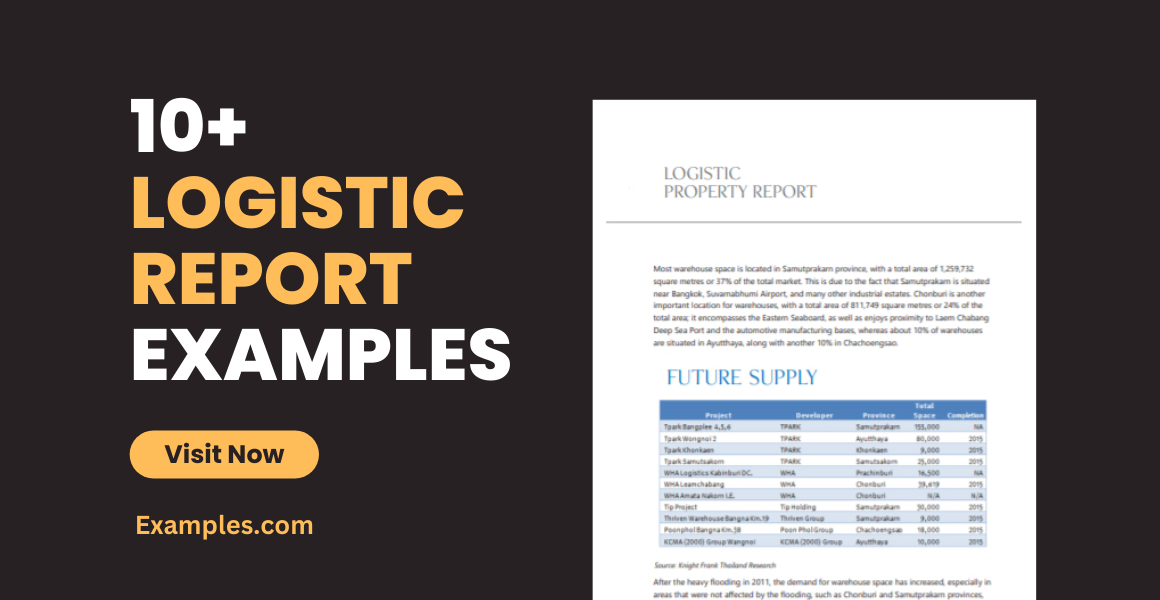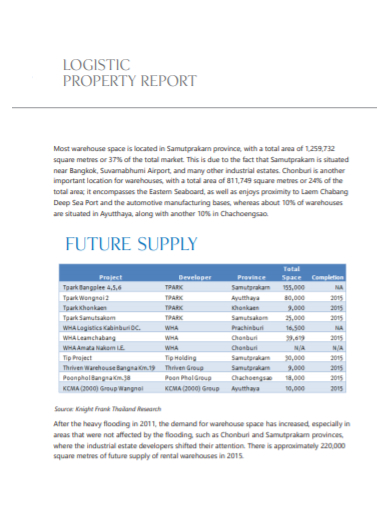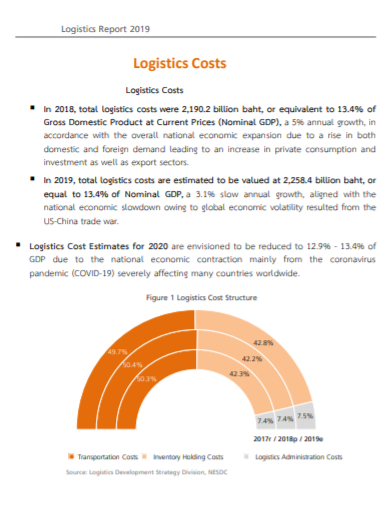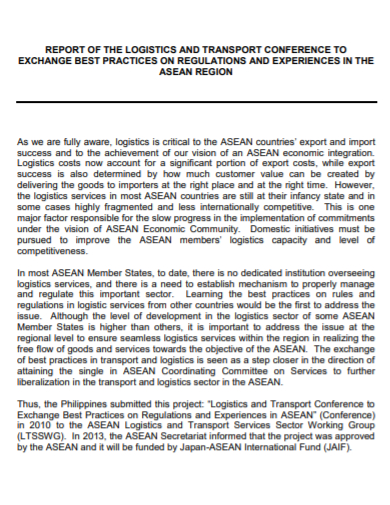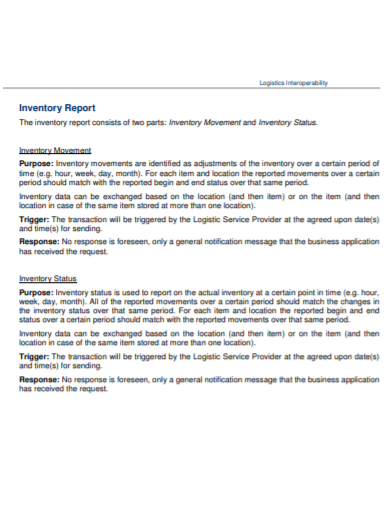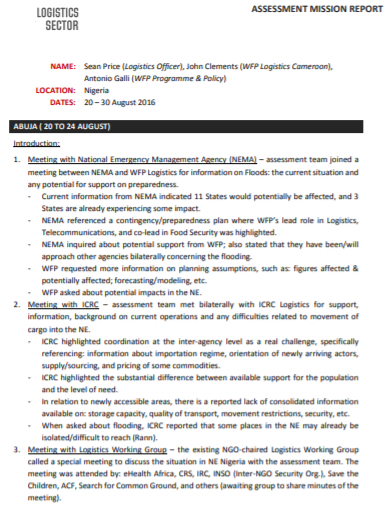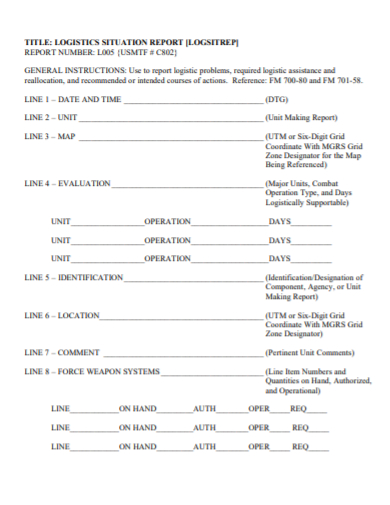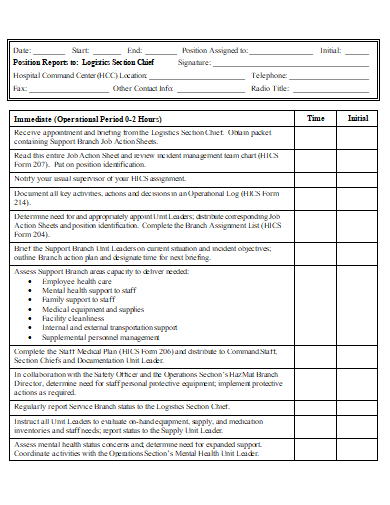10+ Logistic Report Examples to Download
Reports are credible if actual data support their accounts. Accurate accounts are not made up, and no number of alibis can save the business in a disaster. Maintaining a competent research team in the logistics industry necessitates the formation of a reliable research unit. As a result, the reality counts in every logistics study because it directly impacts top-level decision-making. Decisions that result in improved services and benefit maximization will guarantee prosperity and long-term survival in a fiercely competitive market environment.
10+ Logistic Report Examples
1. Logistic Property Report Template
2. Logistic Regression Analysis Report
3. Logistics Cost Report
4. Transport Logistics Report
5. Third-Party Logistics Industry Report
6. Logistics Project Report Template
7. Logistics Inventory Report
8. Logistics Assessment Mission Report
9. Logistics Situation Report
10. Logistics Assessment Report Template
11. Commander Logistics Report
What Is a Logistics Report?
The aim of a logistics report, like every other proposal report, is to include an update. It’s crucial to stay on top of things, particularly when transporting and storing items. Knowing the surroundings allows you to take advantage of the moment.
How To Create a Logistics Report?
Managing a supply chain is a difficult challenge. The logistic process is extensive and includes the manufacturing process, storage, warehousing, and selling. As a result, the logistics sector is massive in scope, necessitating a comprehensive overview. As a result, reports are needed to keep track of activities. So, to get started on your report papers, you can refer to the concise list below.
1. Search for the needed Layout
Since the industry is so large, the best place to begin is with a flow chart of the whole operation. The logistical analysis is essential for understanding your report’s complexity and how to break it down into manageable chunks.
2. Know the Sector
Since the logistics industry is too large, it often decides which sector requires reporting. So get out your organizational map to see how you’re dealing with the warehouse, freight facilities, or production operation. Look up close and pick out the problem spot, or respond to your boss’s order.
3. Ask Questions
Are you supposed to be reporting for something? As a result, you must inquire about the job at hand. Are you going to present any figures? Perhaps Excel report templates would be helpful. Can you have an update on the transportation system? Then you can rely on Word report models to get the job done. Also, your questions will guide you to what you can look for so that you can write a report. As a result, either answer your questions or comply with your boss’s request. Making an overview paper is, once again, part of the step if you’re looking for figures.
4. Gather supporting documents
Collect the inventory papers, statement sheets, and other necessary paperwork. There’s nothing like beginning with article models in Pages with all of the index section’s components. You can look at sample reports online to see what other files you can use with the finished product.
5. Review and be Creative
You must review your report before it is finalized. Often get advice from professionals and provide time for them to double-check the conclusions. Make sure that everything corresponds to the proof. You’ll also require a truthful and error-free presentation. Your document is not only full of interesting facts, but it is also well worth reading. To make the text easier to navigate, make sure the specifics are organized. Often adding creativity from your imagination makes the boss’s eyes entertained and see what you can do with a little bit of style to get their attention.
FAQS
What are the three logistics types?
Inbound logistics, outbound logistics, and reverse logistics are the three types of logistics. The knowledge of these three supply chain directions is crucial, particularly for those who work in the logistics industry.
What is the role of logistics in today’s world?
The method of arranging and performing adequate transportation and storing goods from the point of origin to the end of consumption is known as logistics. Logistics aims to satisfy the needs of customers in a timely and cost-effective manner.
Why am I supposed to learn logistics?
Logistics is a challenging profession, but it also provides a rewarding job experience that emphasizes collaboration and culture. And, if more logistics companies provide workplace preparation and professional growth, you’ll almost certainly have a coach that could help you with it.
Data is critical to making decisions, but timely reports are essential for the logistics sector. Furthermore, the reach of the industry is so vast that keeping track requires commitment. Everything must be double-checked, from minor data to big ones. If you’re planning to produce a logistic report and avoid mistakes while creating one, please use the suggestions stated above and download the free templates to use as an innovative guide when doing so.


